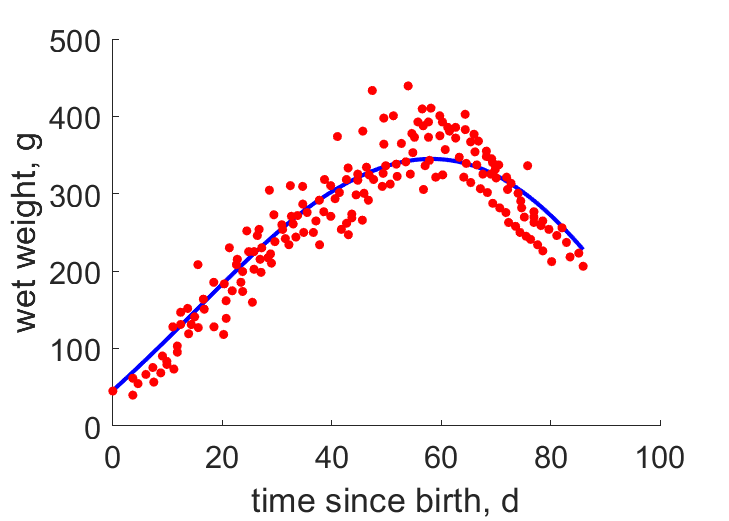Predictions & Data for this entry
| Model: std | climate: MB, MC | migrate: | phylum: |
| COMPLETE = 2.5 | ecozone: MPS | food: biCvf, biCik, biCic | class: |
| MRE = 0.028 | habitat: 0iMc | gender: Dg | order: |
| SMSE = 0.003 | embryo: Tntfm | reprod: O | family: |
Zero-variate data
| Data | Observed | Predicted | (RE) | Unit | Description | Reference |
|---|---|---|---|---|---|---|
| ab | 47 | 45.52 | (0.0315) | d | age at birth | Gard1999 |
| tx | 84.7 | 84.51 | (0.002217) | d | time since birth at fledging | Gard1999 |
| tp | 254.1 | 257.6 | (0.01381) | d | time since birth at puberty | guess |
| tR | 730 | 730 | ( 0) | d | time since birth at 1st brood | guess |
| am | 9125 | 9214 | (0.009752) | d | life span | guess |
| Wwb | 45 | 45.63 | (0.01397) | g | wet weight at birth | Gard1999 |
| Wwi | 630 | 621.2 | (0.01402) | g | ultimate wet weight | Gard1999 |
| Ri | 0.00274 | 0.002744 | (0.001598) | #/d | maximum reprod rate | Wiki |
Uni- and bivariate data
| Data | Figure | Independent variable | Dependent variable | (RE) | Reference |
|---|---|---|---|---|---|
| tW |  | time since birth | wet weight | (0.09898) | Gard1999 |
Pseudo-data at Tref = 20°C
| Data | Generalised animal | Pterodroma axillaris | Unit | Description |
|---|---|---|---|---|
| v | 0.02 | 0.0184 | cm/d | energy conductance |
| p_M | 18 | 508.5 | J/d.cm^3 | vol-spec som maint |
| k_J | 0.002 | 0.02111 | 1/d | maturity maint rate coefficient |
| k | 0.3 | 0.3035 | - | maintenance ratio |
| kap | 0.8 | 0.9327 | - | allocation fraction to soma |
| kap_G | 0.8 | 0.8014 | - | growth efficiency |
| kap_R | 0.95 | 0.95 | - | reproduction efficiency |
Discussion
- Feeding is reduced towards end of nestling period
- Long tp cannot be captured by std model
- Body temperature of Oceanodroma furcata (Youn2013), but that of chick down to 10 C
- mod_1: Puberty is assumed to coincide with fledging with a waiting time to first brood
Acknowledgment
- The creation of this entry was support by the Norwegian Science Council (NFR 255295)
Bibliography